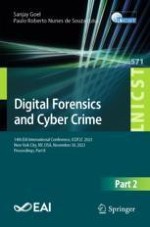2024 | Buch
Digital Forensics and Cyber Crime
14th EAI International Conference, ICDF2C 2023, New York City, NY, USA, November 30, 2023, Proceedings, Part II
herausgegeben von: Sanjay Goel, Paulo Roberto Nunes de Souza
Verlag: Springer Nature Switzerland
Buchreihe : Lecture Notes of the Institute for Computer Sciences, Social Informatics and Telecommunications Engineering
